AUDI R8 SPYDER 2015 Owners Manual
Manufacturer: AUDI, Model Year: 2015, Model line: R8 SPYDER, Model: AUDI R8 SPYDER 2015Pages: 232, PDF Size: 58.36 MB
Page 131 of 232
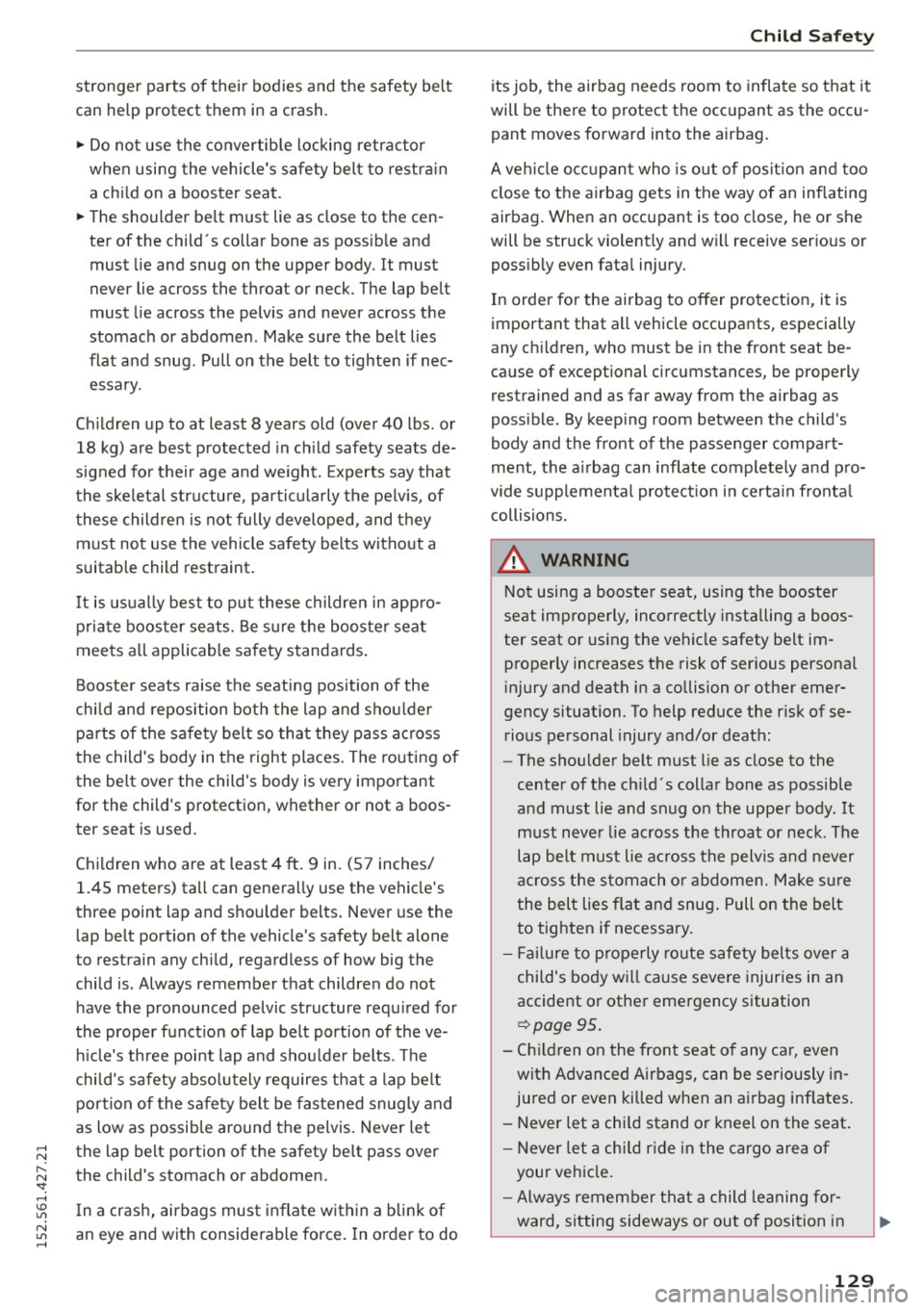
..... N
r-N "': ..... \!) 1.1'1
N 1.1'1 .....
stronger parts of their bodies and the safety belt
can help protect them in a crash.
.,. Do not use the convertible locking retractor
when using the vehicle's safety belt to restrain
a child on a booster seat.
... The shoulder belt must lie as close to the cen
ter of the child 's collar bone as possible and
must lie and snug on the upper body. It must
never lie across the throat or neck. The lap belt
must lie across the pelvis and never across the
stomach or abdomen . Make sure the belt lies
flat and snug. Pull on the belt to tighten if nec essary.
Children up to at least 8 years old (over 40 lbs . or
18 kg) are best protected in child safety seats de
signed for their age and weight. Experts say that
the skeletal structure, particularly the pelvis, of
these children is not fully developed, and they
must not use the vehicle safety belts without a
suitable child restraint.
It is usually best to put these children in appro
priate booster seats. Be sure the booster seat
meets all applicable safety standards.
Booster seats raise the seating position of the
child and reposition both the lap and shoulder
parts of the safety belt so that they pass across
the child's body in the right places. The routing of
the belt over the child's body is very important
for the child 's protection, whether or not a boos
ter seat is used.
Children who are at least 4
ft. 9 in. (57 inches/
1.45 meters) tall can generally use the vehicle's
three point lap and shoulder belts. Never use the lap belt portion of the vehicle's safety belt alone
t o re strain any child, regardless of how big the
child is . Always remember that children do not
have the pronounced pelvic structure required for
the proper function of lap belt portion of the ve
hicle's three point lap and shoulder belts . The
child's safety absolutely requires that a lap belt
portion of the safety belt be fastened snugly and
as low as possible around the pelvis. Never let
the lap belt portion of the safety belt pass over
the child's stomach or abdomen.
In a crash, airbags must inflate within a blink of
an eye and with considerable force. In order to do
Child Safety
its job, the airbag needs room to inflate so that it
will be there to protect the occupant as the occu pant moves forward into the airbag .
A vehicle occupant who is out of position and too
close to the airbag gets in the way of an inflating
airbag. When an occupant is too close, he or she
will be struck violently and will receive serious or
possibly even fatal injury.
In order for the airbag to offer protection, it is
important that all vehicle occupants, especially
any chi ldren, who must be in the front seat be
cause of exceptional circumstances, be properly
restrained and as far away from the airbag as
possible. By keeping room between the child's
body and the front of the passenger compart
ment, the airbag can inflate completely and pro
vide supplemental protection in certain frontal
collisions.
A WARNING
-Not using a booster seat, using the booster
seat improperly, incorrectly installing a boos
ter seat or using the vehicle safety belt im
properly increases the risk of serious personal
injury and death in a collision or other emer
gency situation. To help reduce the risk of se
rious personal injury and/or death :
- The shoulder belt must lie as close to the
center of the child's collar bone as possible
and must lie and snug on the upper body .
It
must never lie across the throat or neck . The
lap belt must lie across the pelvis and never
across the stomach or abdomen. Make sure
the belt lies flat and snug. Pull on the belt
to tighten if necessary.
- Fai lure to properly route safety belts over a
child's body w ill cause severe injuries in an
accident or other emergency situation
~ page 95.
- Children on the front seat of any car, even
with Advanced Airbags, can be seriously in
jured or even killed when an airbag inflates.
- Never let a child stand or kneel on the seat.
- Never let a child ride in the cargo area of
your vehicle.
- Always remember that a child leaning for
ward, sitting sideways or out of position in
129
Page 132 of 232
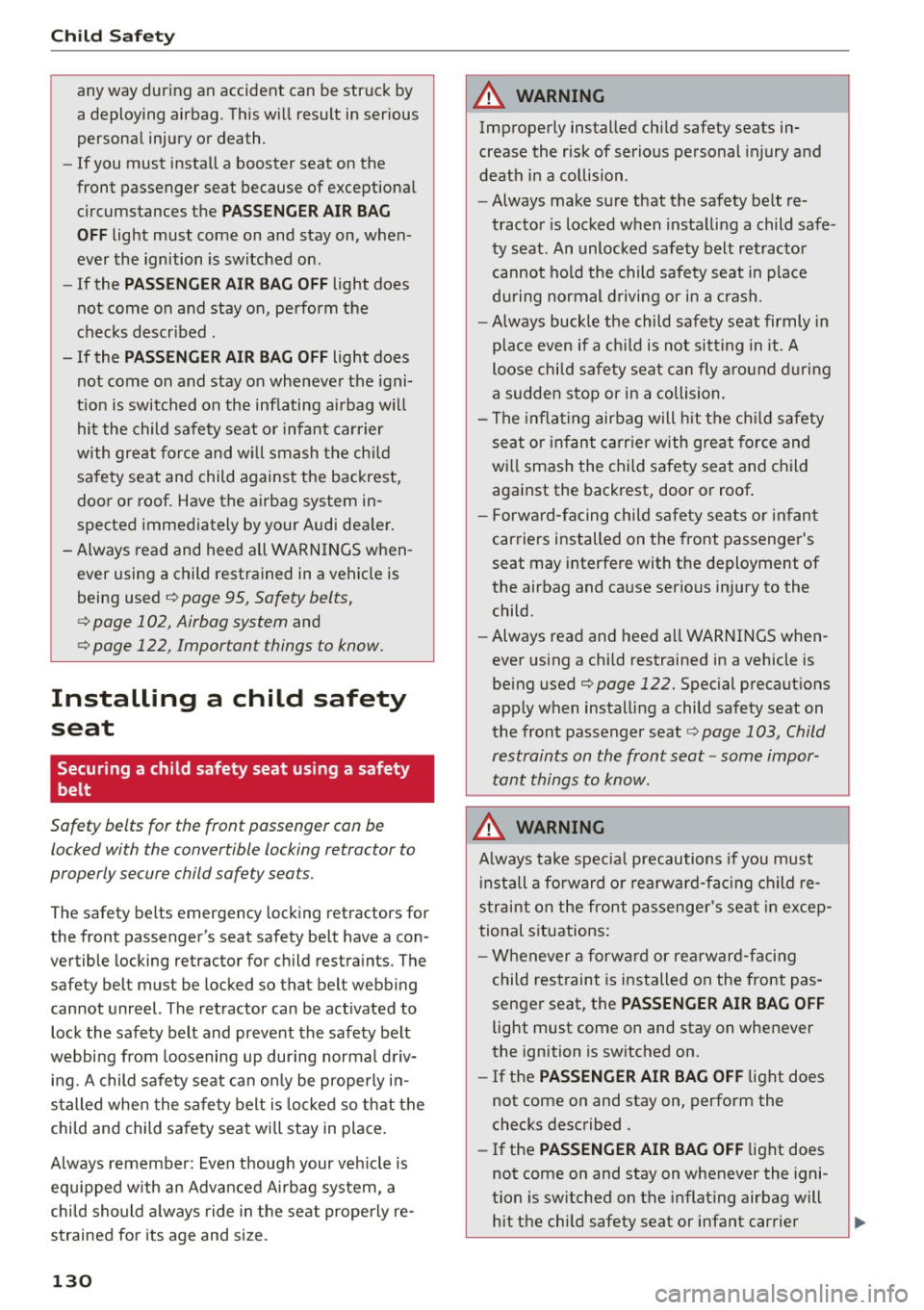
Child Safety
any way during an accident can be struck by
a deploying airbag. This will result in serious personal injury or death.
- If you must install a booster seat on the
front passenger seat because of exceptional
circumstances the
PASSENGER AIR BAG
OFF
light must come on and stay on, when
ever the ignition is switched on .
- If the
PASSENGER AIR BAG OFF light does
not come on and stay on, perform the
checks described .
- If the
PASSENGER AIR BAG OFF light does
not come on and stay on whenever the igni
tion is switched on the inflating airbag will hit the child safety seat or infant carrier
with great force and will smash the child
safety seat and child against the backrest,
door or roof. Have the airbag system in
spected immediately by your Audi dealer.
- Always read and heed all WARNINGS when
ever using a child restrained in a vehicle is
being used
~ page 95, Safety belts,
¢ page 102, Airbag system
and
¢ page 122, Important things to know.
Installing a child safety
seat
Securing a child safety seat using a safety
belt
Safety belts for the front passenger can be
locked with the convertible locking retractor to
properly secure child safety seats .
The safety belts emergency locking retractors for
the front passenger's seat safety belt have a con
vertible locking retractor for child restraints . The
safety belt must be locked so that belt webbing
cannot unreel. The retractor can be activated to
lock the safety belt and prevent the safety belt
webbing from loosening up during normal driv
ing. A child safety seat can only be properly in
stalled when the safety belt is locked so that the
child and child safety seat will stay in place.
Always remember : Even though your vehicle is
equipped with an Advanced Airbag system, a
child should always ride in the seat properly re
strained for its age and size.
130
A WARNING ,.
Improperly installed child safety seats in-
crease the risk of serious personal injury and
death in a collision .
-
-Always make sure that the safety belt re
tractor is locked when installing a child safe
ty seat . An unlocked safety belt retractor
cannot hold the child safety seat in place
during normal driving or in a crash.
-Always buckle the child safety seat firmly in
place even if a child is not sitting in it. A
loose child safety seat can fly around during
a sudden stop or in a collision.
- The inflating airbag will hit the child safety
seat or infant carrier with great force and
will smash the child safety seat and child
against the backrest, door or roof.
- Forward-facing child safety seats or infant
carriers installed on the front passenger's
seat may interfere with the deployment of
the airbag and cause serious injury to the
child.
- Always read and heed all WARNINGS when
ever using a child restrained in a vehicle is being used
¢page 122. Special precautions
apply when installing a child safety seat on
the front passenger seat
¢ page 103, Child
restraints on the front seat -some impor
tant things to know.
A WARNING
Always take special precautions if you must
install a forward or rearward-facing child re
straint on the front passenger's seat in excep
tional situations:
- Whenever a forward or rearward-facing
child restraint is installed on the front pas
senger seat, the
PASSENGER AIR BAG OFF
light must come on and stay on whenever
the ignition is switched on.
- If the
PASSENGER AIR BAG OFF light does
not come on and stay on, perform the
checks described .
- If the
PASSENGER AIR BAG OFF light does
not come on and stay on whenever the igni
tion is switched on the inflating airbag will
hit the child safety seat or infant carrier .,,.
Page 133 of 232
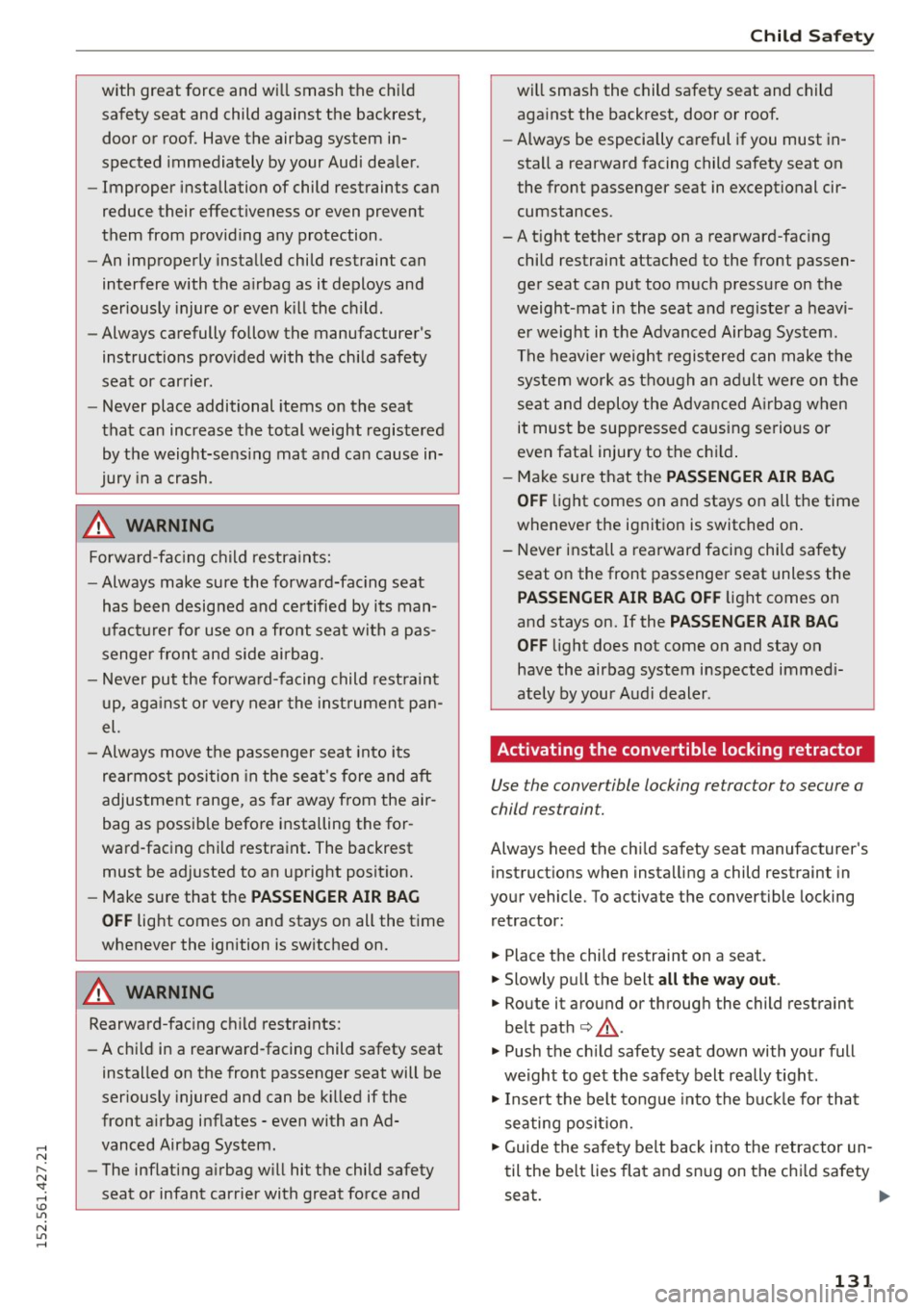
..... N
r-N "': ..... \!) ..,.,
N ..,., .....
with great force and will smash the child
safety seat and child against the backrest,
door or roof. Have the airbag system in
spected immediately by your Audi dealer.
- Improper installation of child restraints can
reduce their effectiveness or even prevent
them from providing any protection .
- An improperly installed child restraint can
interfere with the airbag as it deploys and
seriously injure or even kill the child.
- Always carefully follow the manufacturer's
instructions provided with the child safety
seat or carrier .
- Never place additional items on the seat
that can increase the total weight registered
by the weight-sensing mat and can cause in
jury in a crash.
A WARNING
Forward-facing child restraints:
-Always make sure the forward-facing seat
has been designed and certified by its man
ufacturer for use on a front seat with a pas
senger front and side airbag.
- Never put the forward-facing child restraint
up, against or very near the instrument pan
el.
-Always move the passenger seat into its
rearmost position in the seat's fore and aft
adjustment range, as far away from the air
bag as possible before installing the for
ward-facing child restraint. The backrest must be adjusted to an upright position.
- Make sure that the
PASSENGER AIR BAG
OFF
light comes on and stays on all the time
whenever the ignition is switched on.
A WARNING
Rearward-facing child restraints:
- A child in a rearward-facing child safety seat
installed on the front passenger seat will be
seriously injured and can be killed if the
front airbag inflates - even with an Ad
vanced Airbag System .
- The inflating airbag will hit the child safety
seat or infant carrier with great force and
Child Safety
will smash the child safety seat and child
against the backrest, door or roof.
- Always be especially careful if you must in
stall a rearward facing child safety seat on
the front passenger seat in exceptional cir
cumstances.
- A tight tether strap on a rearward-facing
child restraint attached to the front passen
ger seat can put too much pressure on the
weight -mat in the seat and register a heavi
er weight in the Advanced Airbag System .
The heavier weight registered can make the
system work as though an adult were on the
seat and deploy the Advanced Airbag when
it must be suppressed causing serious or
even fatal injury to the child.
- Make sure that the
PASSENGER AIR BAG
OFF
light comes on and stays on all the time
whenever the ignition is switched on.
- Never install a rearward facing child safety
seat on the front passenger seat unless the
PASSENGER AIR BAG OFF light comes on
and stays on. If the
PASSENGER AIR BAG
OFF
light does not come on and stay on
have the airbag system inspected immedi
ately by your Audi dealer .
Activating the convertible locking retractor
Use the conver tible locking re trac tor to secure a
child restraint.
Always h eed the child safety seat manufacturer's
instructions when installing a child restraint in
your vehicle. To ac tiva te the convertible locking
retractor:
.. Place the child restraint on a seat.
.. Slowly pull the belt
all the way out .
.. Route it around or through the child restraint
belt path
c:> ,&. .
.. Push the child safety seat down with your full
weight to get the safety belt really tight.
.,. Insert the belt tongue into the buckle for that
seating position.
.. Guide the safety belt back into the retractor un
til the belt lies flat and snug on the child safety
seat. ..,.
131
Page 134 of 232
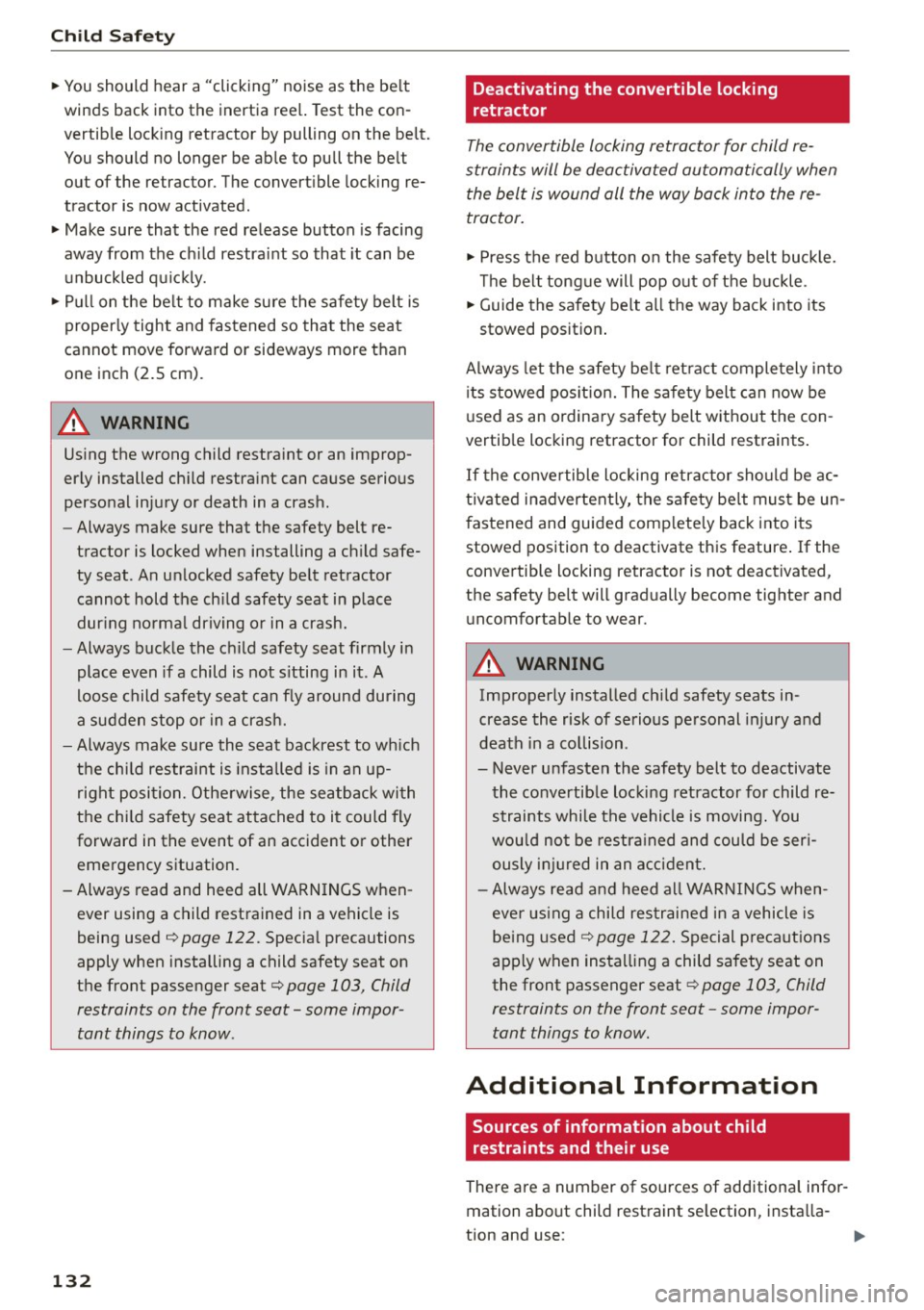
Child Safety
"' You should hear a "clicking" noise as the be lt
winds back into the inertia ree l. Test the con
vertib le lock ing retractor by pulling on the belt .
You should no longer be ab le to pull the be lt
out of the retractor. The convert ible locking re
tractor is now activated.
"' Make sure that the red release button is facing
away from the ch ild restraint so that it can be
unbuckled quic kly.
"' Pull on the be lt to make sure the safety belt is
properly tight and fastened so tha t the seat
cannot move forwa rd or sideways more than
one inc h (2.5 cm).
A WARNING
Us ing the wrong child restra int or an improp
er ly installed ch ild restra int can cause serious
personal injury or death in a crash .
- Always make sure that the safety belt re
tractor is locked when installing a child safe
ty seat . An un locked safety be lt retractor
cannot hold the ch ild safety seat in place
dur ing no rma l driving o r in a crash.
- Always buckle the child safety seat firmly in
place even if a child is not s itting in it . A
loose child safety seat can fly around du ring
a sudden stop or in a crash.
- Always make sure the seat backrest to wh ich
t h e chi ld restraint is insta lled i s in an up
right posi tion. Othe rwise , the seatback wi th
the chi ld safety seat at tached to it could fly
forward in the event of an accident o r other
emergency situation.
- Always read and heed all WARN INGS when
ever using a child restrained in a vehicle is
being used
r::!) page 122. Specia l precautions
apply when installing a child safety seat on
the front passenger seat¢
page 103, Child
restraints on the front seat -some impor
tant things to know .
132
· Deactivating the convertible locking
retractor
The convertible locking retractor for child re
straints will be deactivated automatically when the belt is wound all the way back into the re
tractor.
"' Press the red button on the safety belt buckle.
T he be lt tong ue will pop out of the b uc kle .
"' Guide the safety be lt a ll the way back into its
stowed position .
Always let the safety be lt ret ract completely i nto
i ts stowed pos it ion. The safe ty belt can now be
u sed as an ordina ry safety belt without the con
vertib le locking retractor for child restraints .
If the conve rtib le locking retractor sho uld be ac
tivated inadvertent ly, the sa fety be lt mus t be un
fastened and guided comp letely back into its
stowed position to deactivate this feature .
If the
convertible locking retractor is not deactivated,
the safety belt will gradually become tighter and
uncomfortable to wear.
A WARNING
Improperly installed chi ld safety seats in
crease the risk of serious pe rsonal injury and
death in a co llision.
-
- Never unfasten the safety belt to deactivate
the convertible locki ng retractor for child re
straints while the vehicle is moving. You
wou ld not be restra ined and could be ser i
ously inj ured in an accident.
- Always read and heed all WARNINGS when
eve r using a child res trained in a vehicle is
be ing used
¢page 122. Special precaut ions
apply when installing a child sa fety seat on
the front passenger seat
¢ page 103, Child
restraints on the front seat -some impor
tant things to know.
Additional Information
Sources of information about child
. restraints and their use
There are a number of sources of additiona l infor
mation about child restraint se lection, insta lla
tion and use :
Page 135 of 232
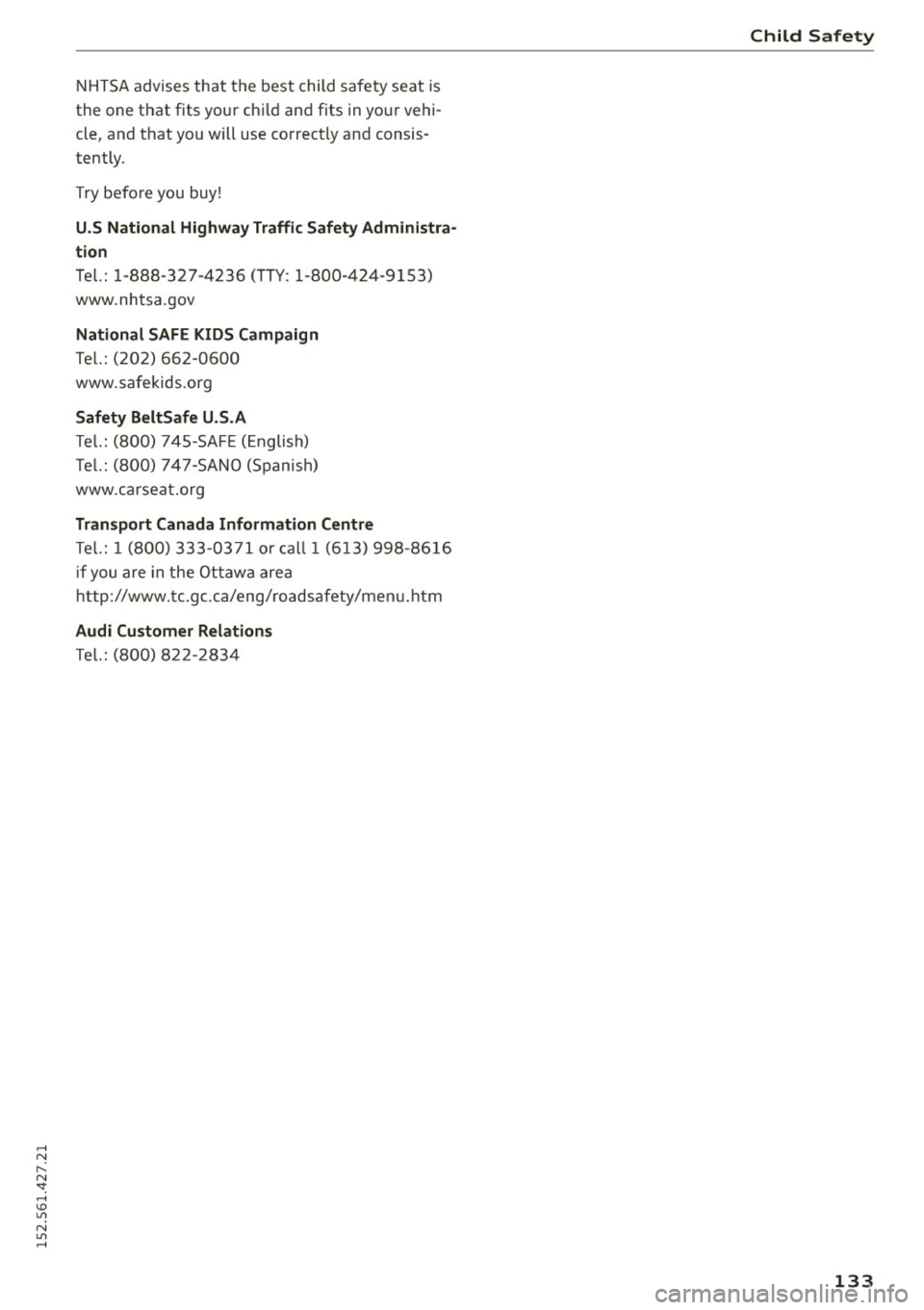
..... N
r-N "': ..... \!) 1.1"1
N 1.1"1 .....
NHTSA advises that the best child safety seat is
the one that fits your child and fits in your vehi
cle, and that you will use correctly and consis
tently.
Try before you buy!
U.S National Highway Traffic Safety Administra
tion
Tel.: 1-888-327-4236 (TTY: 1-800-424-9153)
www.nhtsa.gov
National SAFE KIDS Campaign
Tel.: (202) 662-0600
www.safekids.org
Safety BeltSafe U.S.A
Tel.: (800) 745-SAFE (English)
Tel.: (800) 747-SANO (Spanish)
www.carseat.org
Transport Canada Information Centre
Tel.: 1 (800) 333-0371 or call 1 (613) 998-8616
if you are in the Ottawa area
http ://www. tc.gc.ca/eng/roadsafety/men u. htm
Audi Customer Relations
Tel.: (800) 822-2834
Child Safety
133
Page 136 of 232
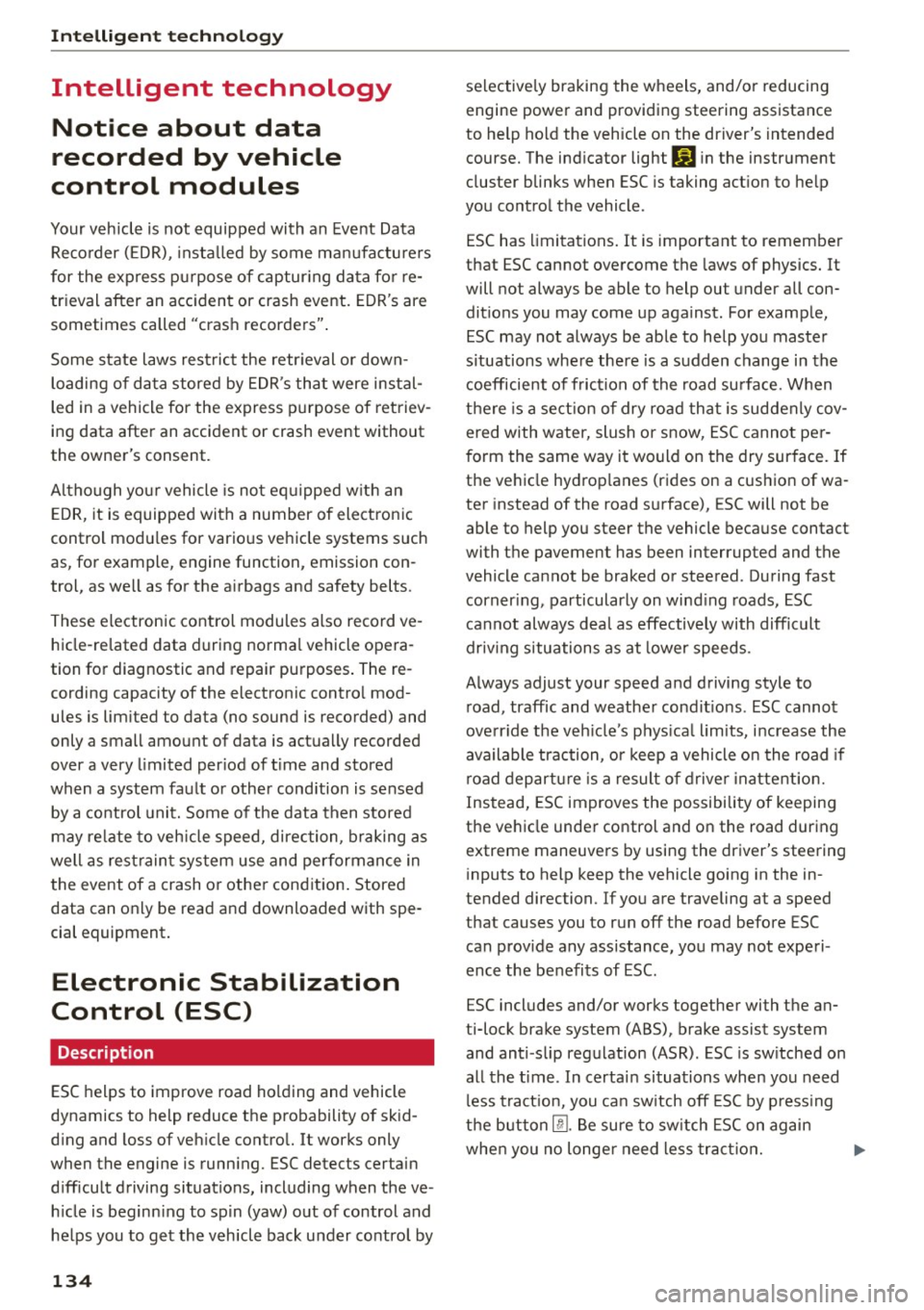
Intelligent technology
Intelligent technology
Notice about data
recorded by vehicle
control modules
Your vehicle is not equipped with an Event Data
Reco rder (EDR) , insta lled by some manufactu rers
for the express pu rpose of captur ing data fo r re
trieval after an accident or crash event. ED R 's are
sometimes called "crash recorders" .
Some state laws restrict the retr ieval or down
loading of da ta stored by EDR's that were instal
led in a vehicle for the express p urpose of retriev
ing data after an accident or crash event without
the owner's consent.
Al though you r vehicle is not eq uipped w ith an
E DR, it is equipped with a number of electronic
control modu les for vario us vehicle systems such
as, for example, engine function, emission con
trol, as we ll as for the airbags and safety belts.
These electronic control modules also record ve
hicle-related data during norma l vehicle opera
tion for diagnostic and repair purposes . The re
cording capacity of the electronic contro l mod
ules is lim ited to data (no sound is recorded) and
only a small amount of data is actually recorded
over a very l imited per iod of t ime and stored
when a system fault or other condition is sensed by a control unit. Some of the data then stored
may re late to veh icle speed, direction, braking as
well as restraint system use and performance in
the event of a crash o r other cond ition . Stored
data can only be read and downloaded with spe
cial equipment.
Electronic Stabilization
Control (ESC)
Description
ESC helps to improve road holding and vehicle
dynamics to help reduce the probability of sk id
d ing and loss of veh icle contro l.
It works only
when the engine is runn ing. ESC detects certain
d ifficult driving situations, including when the ve
h icle is beginn ing to spin (yaw) out of control and
he lps you to get the veh icle back under control by
134
selective ly braking the wheels, and/or reducing
engine power and providing steering assistance
to help ho ld the veh icle on the driver's intended
course. The ind icator light
GJ in the instrument
cluster blinks when ESC is taking act ion to help
you contro l the vehicle .
ESC has limitations. It is important to remember
that ESC cannot overcome the laws of physics. It
will not always be able to help out under all con
dit ions you may come up against. For example,
ESC may not always be able to help you master
s ituations where there is a sudden change in the
coefficient of fric tion of the road surface. When
there is a sect ion of dry road that is suddenly cov
ered with water, slush or snow, ESC cannot per
f orm the same way it would on the dry surface . If
the vehicle hydrop lanes (rides on a cushion of wa
ter instead of the road surface), ESC will not be
able to help you steer the vehicle because contact
with the pavement has been interrupted and the
vehicle cannot be braked or steered . During fast
corner ing, particularly on wind ing roads, ESC
cannot always dea l as effectively with difficult
driv ing situations as at lower speeds .
Always adjust your speed and driving style to road, traffic and weather condit ions . ESC cannot
overr ide the veh icle's phys ica l limits, increase the
available traction, or keep a vehicle on the road if
road departure is a result of driver inattention.
Instead, ESC improves the possibility of keeping
the vehicle under control and on the road during
extreme maneuvers by using the driver's steering
inputs to help keep the vehicle going in the in
tended direction. If you are traveling at a speed
that causes you to run off the road before ESC
can prov ide any assistance, you may not experi
ence the benefits of ESC.
ESC includes and/or works together with the an
ti-lock brake system (ABS), brake assist sys tem
and anti -slip regulation (ASR) . ESC is sw itched on
all the t ime . In certai n situations when you need
less tract ion, you ca n sw itch off ESC by p ress ing
the button
l!l . Be sure to sw itch ESC on again
when you no longe r need less traction. .,..
Page 137 of 232
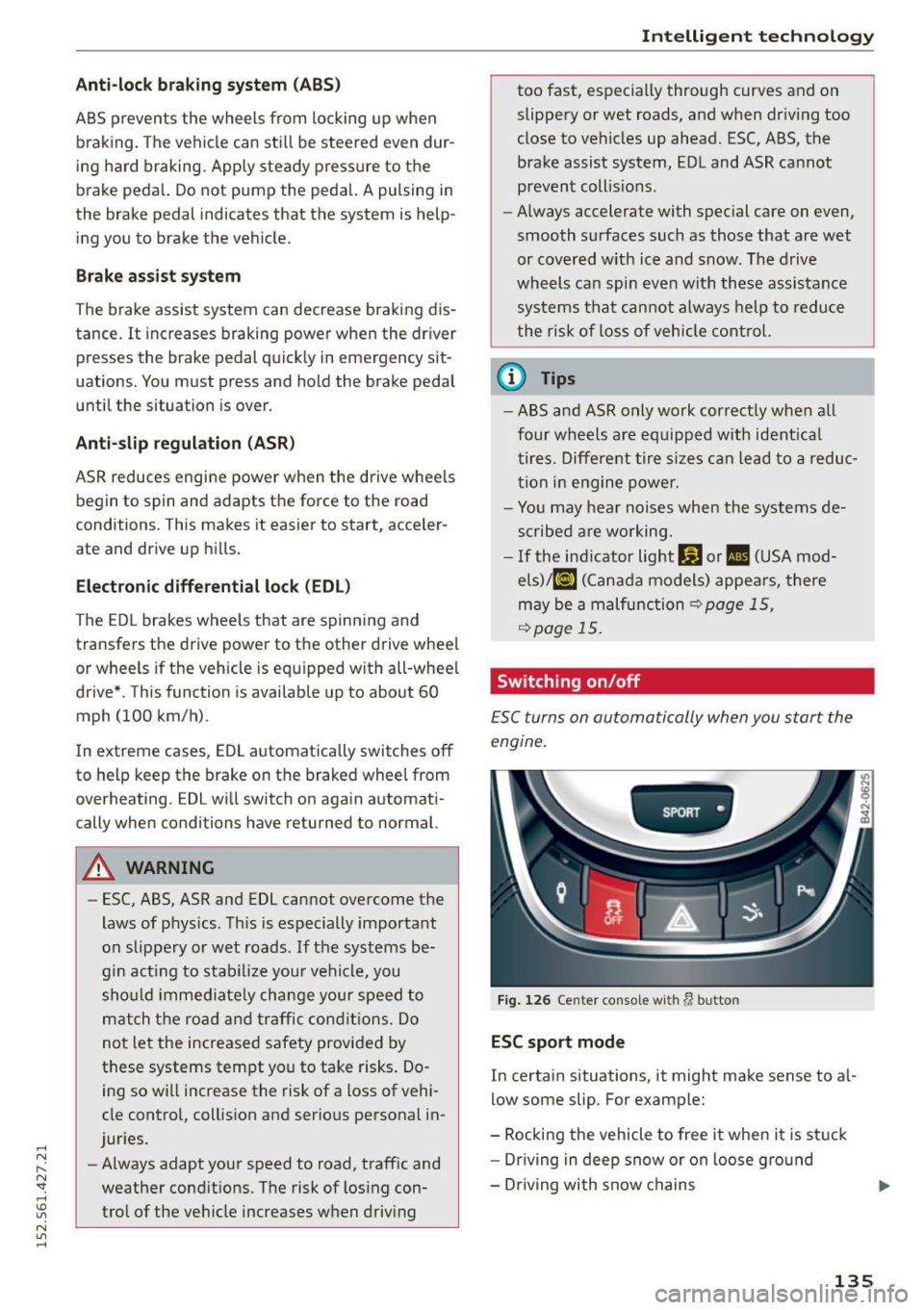
.... N
l'
N "1: .... I.O
"' N
"' ....
Anti-loc k br aking sy stem (ABS )
ABS prevents the wheels from locking up when
brak ing . T he vehicle can st ill be stee red even dur
ing hard braking. App ly steady pressure to the
brake peda l. Do not pump the peda l. A pulsing in
the brake pedal indicates that the system is help
ing you to brake the vehicle.
Brake assist sy ste m
The brake assist system can decrease braking dis
tance. It increases braking power when the dr iver
presses the brake pedal quick ly in emergency sit
uations. You must press and ho ld the brake pedal
until the situation is over.
Anti -slip regulation (ASR )
ASR reduces engine power when the drive whee ls
begin to spin and adapts the force to the road
conditions. This makes it easier to start, acceler
ate and dr ive up h ills.
Electronic diff erential lock (EDL )
The EDL brakes wheels that are spinning and
transfers the drive power to the other drive wheel or wheels if the vehicle is equipped w ith all-whee l
drive*. This function is available up to about 60
mph (100 km/h) .
I n extreme cases , EDL automatically switches off
to help keep the brake on the braked wheel from
overheating . EDL wi ll switch on again automati
cally when conditions have returned to normal.
A WARNING
- ESC, ABS, ASR and EDL cannot overcome the
laws of phys ics. Th is is especially important
on slippery or wet roads. If the syst ems be
gin act ing to stab ilize your vehicle, you
sho uld immediately cha nge your speed to
match the roa d and traffic con ditions. Do
not let the increased safety provided by
these systems tempt you to take risks . Do
ing so wi ll increase the risk of a loss of vehi
cle contro l, collis ion and serio us personal in
juries .
- Always adapt your speed to road, traffic and
weather cond it ions. The risk of losing con
tro l of the veh icle increases when driving
Int ellig ent t echnolo gy
too fast, especially through curves and on
slippery or wet roads, and when dr iving too
close to vehicles up ahead. ESC, ABS, the
brake assist system, EDL and ASR cannot
prevent coll is ions .
- Always accelerate with special care on even,
smooth surfaces such as those that are wet
or covered with ice and snow. The drive
wheels can spin even with these assistance sys tems that cannot always help to reduce
the risk of loss of veh icle control.
(D Tips
- ABS and ASR only wo rk correctly when all
four wheels are eq uipped with ident ical
tire s. Different tire s izes can lead to a reduc
t ion i n engine power.
- Yo u may hear noises when the systems de
sc ribed a re wo rking.
- If the ind icator light GJ or II (USA mod
els) ;tiJ (Canada models) appea rs, there
may be a malfunction~
page 15,
~ page 15.
Switching on/off
ESC turns on automatically when you start the
engine.
SPORT •
Fig . 12 6 Cente r co nsole wit h lJ bu tto n
ESC sport mode
In certain situations, it might make sense to a l
low some slip. For example:
- Rocking the vehicle to free it when it is st uck
- Driving in deep snow or on loose gro und
- Dr iving with snow chains
135
Page 138 of 232
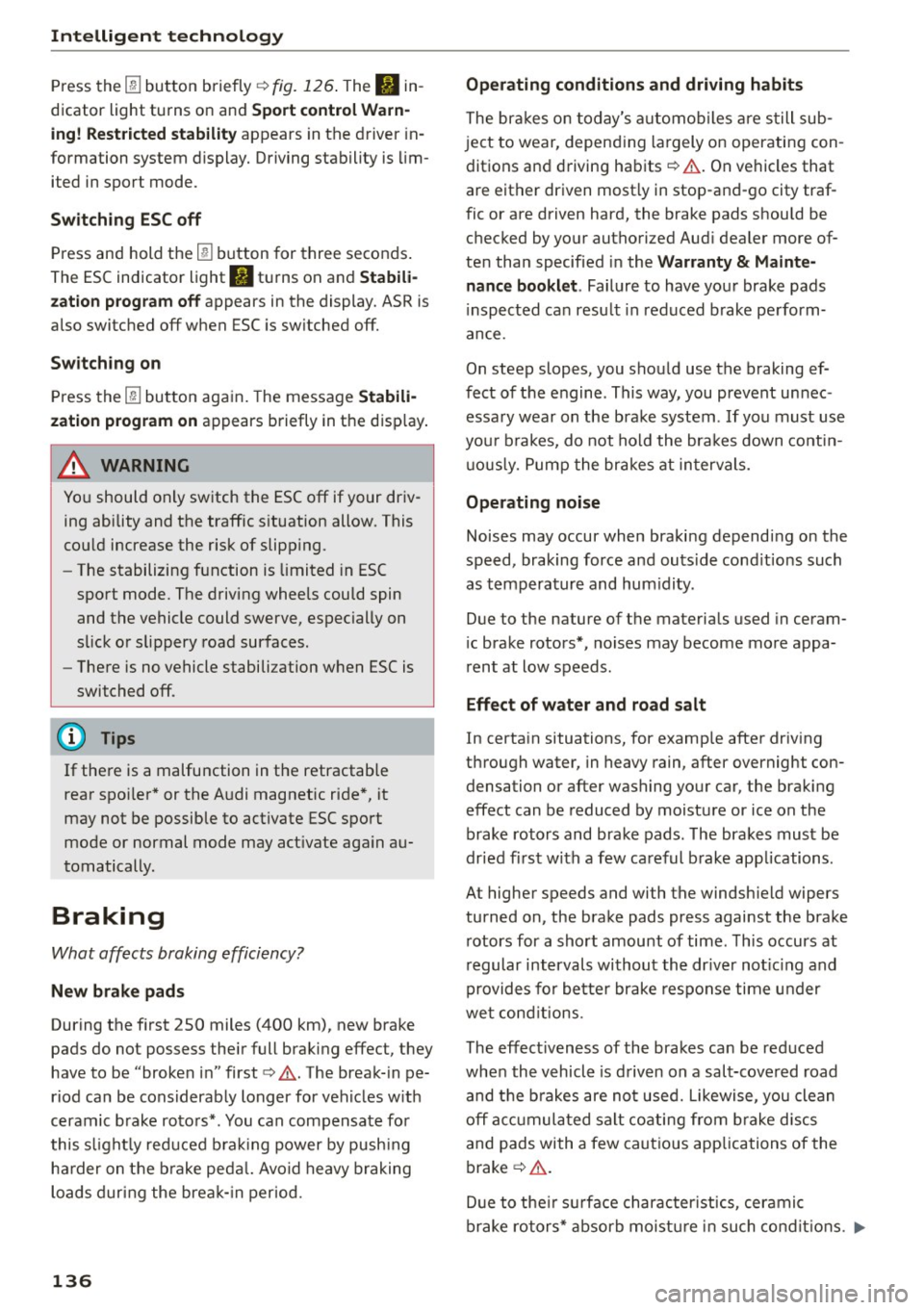
Intelligent technology
Press the I!! button briefly¢ fig. 126 . The II in
dicator light turns on and Sport control Warn
ing! Restricted st abilit y appears in the driver in
formation system d isplay. Driving stability is lim
ited in sport mode.
Sw itch ing ESC off
Press and hold the
l!I button for three seconds .
The ESC indicator light
fl turns on and Stabil i
z atio n prog ram off appears in the display. ASR is
also switched off when ESC is sw itched off.
Sw itch ing on
Press the
l!J button again. The message Stabili
zation progr am on appears briefly in the disp lay .
_& WARNING
You should only sw itch the ESC off if your dr iv
ing ability and the traffic s ituation allow. This
could increase the risk of slipp ing.
- The stabilizing function is limited in ESC
sport mode. The driving wheels could spin and the vehicle could swerve, especially on
slick or slippery road surfaces.
- There is no vehicle stabilization when ESC is
switched off.
(D Tips
If there is a malfunction in the retractable
rear spo iler* or the A udi magnetic ride*, it
may not be possible to activate ESC sport
mode or normal mode may act ivate aga in au
tomatically.
Braking
What affects braking efficiency?
New brake pad s
During the f irst 250 miles (400 km), new brake
pads do not possess the ir full braking effect, they
have to be "broken in" first¢.&. . The break- in pe
riod can be considerab ly longer for vehicles w ith
ceramic b rake roto rs*. You can compensate for
this s light ly reduced b ra ki ng power by push ing
ha rder on the b rake peda l. Avoid heavy braking
loads during the bre ak-in period.
136
Operating conditions and driving habits
The bra kes on today's automobiles a re s till sub
j ect to wear, depend ing largely on operating con
ditions and driving habits ¢& . On vehicles that
a re either driven most ly in stop-and-go city traf
fic or are driven hard, the brake pads should be
checked by your authorized Aud i dealer more of
te n tha n specified in the Warranty
& Maint e
nance bookl et. Failure to have you r brake pads
i nspected can resu lt in reduced b rake pe rform
ance.
On steep slopes, you shou ld use the braking ef
fect of the engine . This way, you prevent un nec
essary wear on the brake system . If you must use
you r brakes, do not hold the bra kes down cont in
u o usly. Pump the brakes at in tervals.
Operating noise
Noises may occur when braki ng depending on the
speed, braking force and outs ide cond it ions such
as tempera ture and hum idity.
Due to the nature of the materia ls used i n ceram
i c brake rotors*, noises may become more appa
r ent at low speeds.
Effect of water and road salt
In certa in situations, for examp le after driv ing
through water , in heavy rain, after overnight con
densation or after washing your car, the braking
effect can be reduced by moisture or ice on the
brake rotors and brake pads . The brakes must be
dr ied fi rst w ith a few careful b rake app lications.
At higher speeds and with the windsh ield wipers
turned on, the brake pads press against the brake r otors for a short amount of time. This occurs at
r egular intervals without the dr iver not ic ing and
provides fo r be tter brake response time under
wet cond it ions.
The effect iveness of the brakes ca n be red uced
when the v ehicle is d riv en on a salt-cove red road
and the b rakes are no t used. Likewise, you clean
off a ccumula ted salt coating from b rake d iscs
and pads with a few ca utious app lications of the
brake ¢& .
D ue to the ir sur fa ce character istics, cerami c
brake ro tors * absorb moistu re in such co ndi tions . ..,.
Page 139 of 232
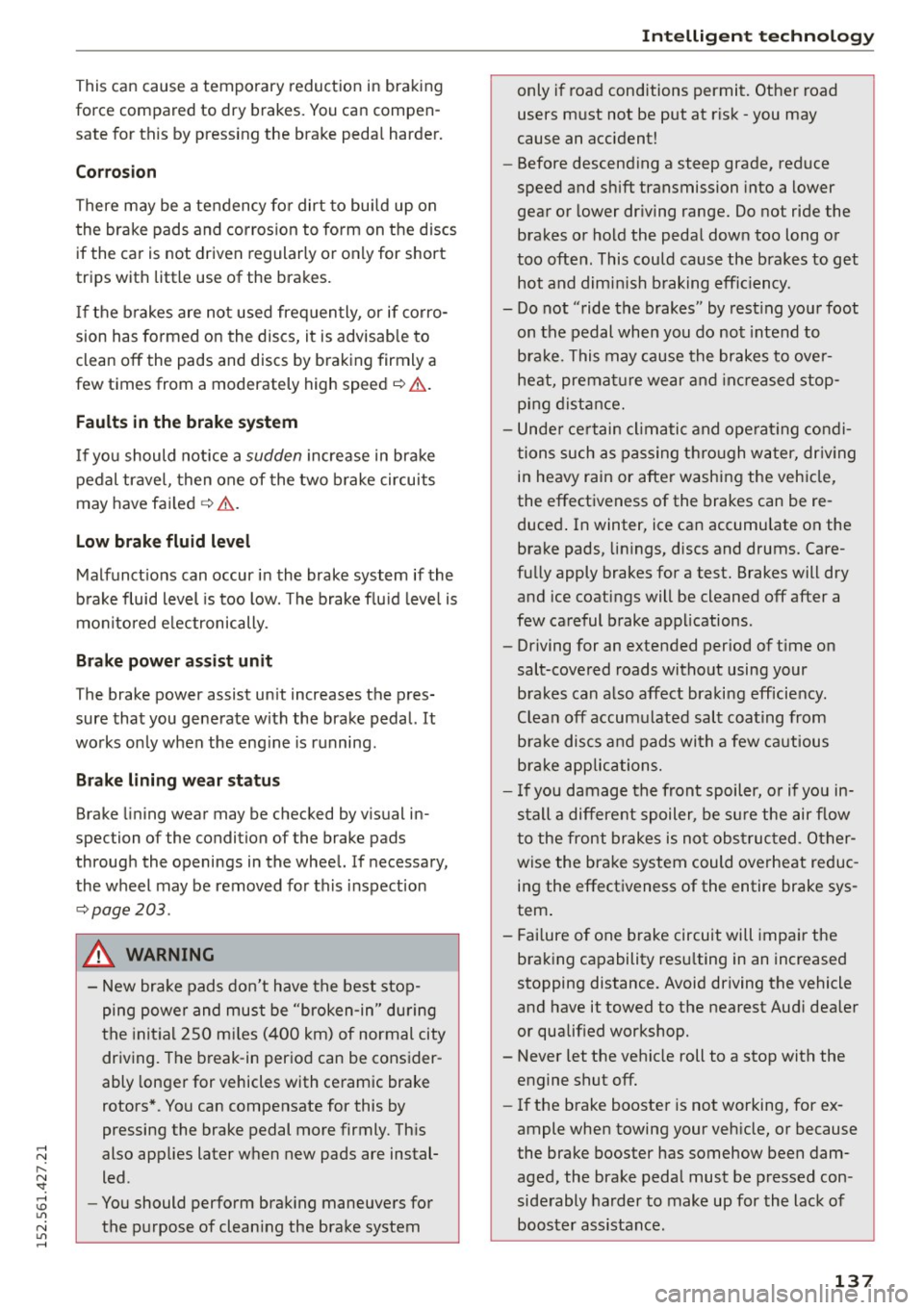
..... N
r-N "': ..... \!) 1.1'1
N 1.1'1 .....
This can cause a temporary reduction in braking
force compared to dry brakes. You can compen
sate for this by pressing the brake pedal harder.
Cor ro sion
There may be a tendency for dirt to bui ld up on
the brake pads and corrosion to fo rm on the discs
if the car is not driven regularly or only for short
trips with little use of the brakes.
If the b rakes are not used frequently, or if corro
sion has formed on the discs, it is advisab le to
clean off the pads and discs by braking firmly a
few times from a moderately high speed
c:> &. .
Faults in the brake sy stem
If you should notice a sudden increase in brake
pedal travel, then one of the two brake circuits
may have fai led
c:> .&, .
Low brak e flu id le vel
Malfunct ions can occur in the brake system if the
brake fluid level is too low. The brake flu id leve l is
monitored e lectronically.
Br ake power assis t un it
T he brake power assist unit increases the pres
sure that you generate with the brake pedal.
It
works only when the eng ine is running .
Brak e lining wear sta tu s
Brake lining wear may be checked by visual in
spection of the condition of the brake pads
through the openings in the wheel. If necessary,
the wheel may be removed for this inspection
c:> page 203 .
.8, WARNING
-New brake pads don't have the best stop
ping power and must be "broken-in" during
the init ial 250 mi les ( 400 km) of normal city
driving. The break -in period can be consider
ably longer for vehicles with ceramic brake
rotors *. You can compensate for this by
pressing the brake pedal more firmly. This
also applies later when new pads are instal
led .
- You should perform brak ing maneuvers for
the purpose of clean ing the brake system
Int elli ge nt te chn olo gy
only if road conditions permit. Other road
users must not be put at r isk -you may
cause an accident!
- Before descending a steep grade, reduce
speed and sh ift transmission into a lower
gear or lower dr iving range. Do not ride the
brakes or hold the pedal down too long or
too often. This could cause the bra kes to get
hot and dimin ish braking effic iency .
- Do not "ride the brakes" by rest ing your foot
on the pedal when you do not intend to
brake. This may cause the brakes to over
heat, premat ure wear and increased stop
ping distance.
- Under certain cl imatic and operat ing condi
tions such as passing thro ugh water, dr iv ing
in heavy rain or after washing the vehicle,
the effectiveness of the brakes can be re
duced . In winter, ice can accumulate on the
brake pads, lin ings, discs and drums. Care
fully apply brakes for a test. Brakes will dry and ice coatings will be cleaned off after a
few careful brake applications.
- Driving for an extended period of t ime on
salt-covered roads without using your brakes can also affect braking efficiency .
Clean off accum ulated salt coating from
b rake discs and pads with a few cautious
brake applications.
- If you damage the front spoiler, or if you in
stall a different spoiler, be su re the air flow
to the front brakes is not obstructed . O ther
wise the brake system could overheat reduc
ing the effectiveness of the entire brake sys
tem .
- Fai lure of one brake circuit will impai r the
braking capability resu lting in an increased
stopping distance . Avoid driving the vehicle
and have it towed to the nearest Aud i dea ler
or qualif ied workshop.
- Never let the vehicle roll to a stop with the
engine shut off.
- If the brake booster is not working, for ex
ample when towing your veh icle, or because
the brake booster has somehow been dam
aged, the brake pedal must be pressed con
siderably harder to make up for the lack of booster assistance.
1 37
Page 140 of 232
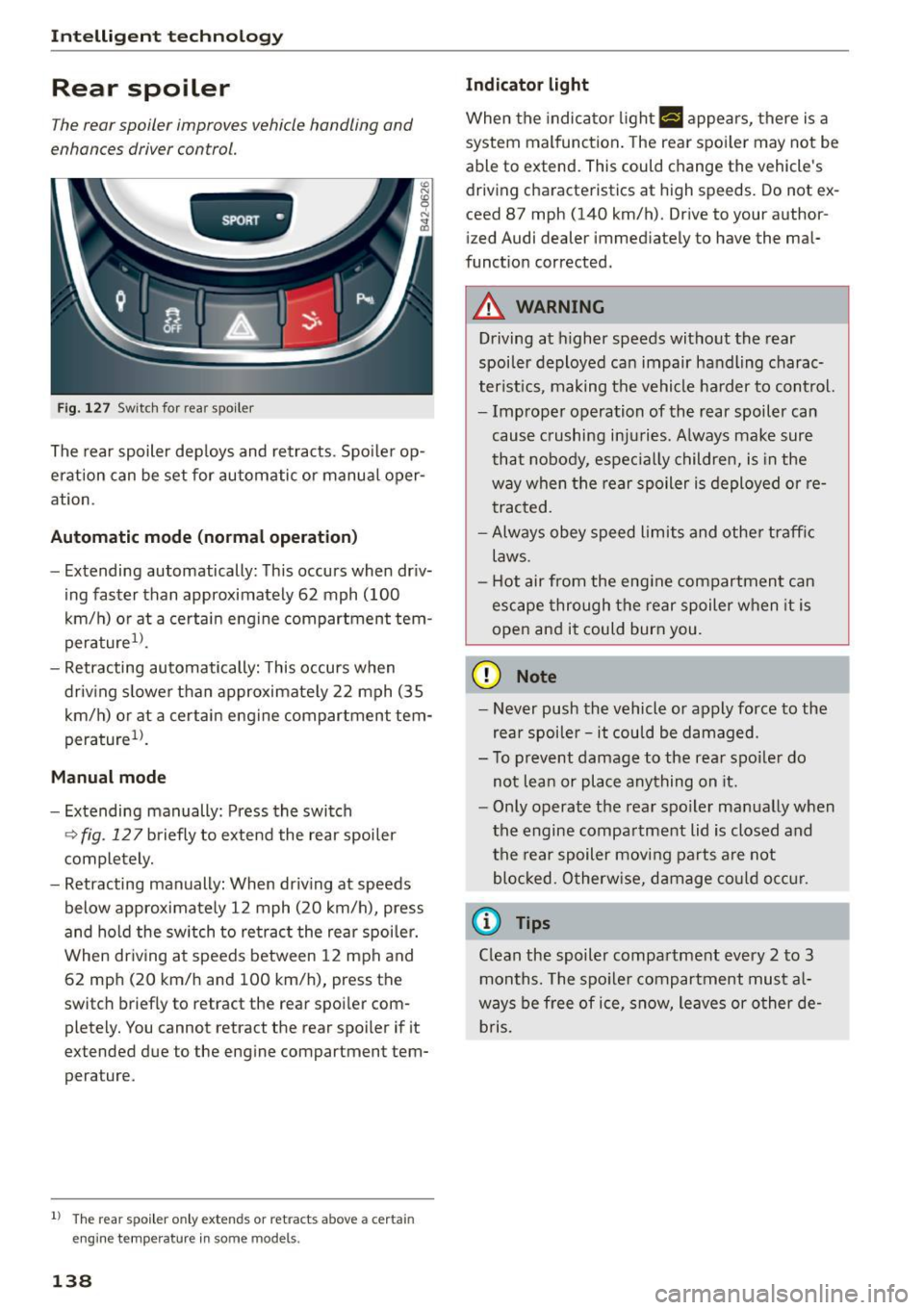
Intelligent technology
Rear spoiler
The rear spoiler improves vehicle handling and
enhances driver control.
SPORT •
Fig. 127 Switch for rear spoiler
The rear spoiler deploys and retracts. Spo iler op
eration can be set for automatic or manual oper
ation.
Automatic mode (normal operation)
-Extending automatically: This occurs when driv
ing faster than approximately
62 mph (100
km/h) or at a certain engine compartment tem
perature1l.
- Retracting automatically: This occurs when
driv ing s lower than approximate ly
22 mph (35
km/h) or at a certain engine compartment tem
perature1l.
Manual mode
- Extending manually: Press the switch
~ fig. 12 7 briefly to extend the rear spoi ler
completely.
- Retracting manually: When dr iving at speeds
below approximately
12 mph (20 km/h), press
and hold the switch to retract the rear spoiler.
When dr iving at speeds between
12 mph and
62 mph (20 km/h and 100 km/h), press the
switch briefly to retract the rear spoiler com
pletely. You cannot retract the rear spoiler if it
extended due to the engine compartment tem
perature.
1 > The rear spoiler only extends or retracts above a certain
e ngine temperature in some mode ls.
138
Indicator light
When the indicator light I-· appears, there is a
system malfunction. The rear spoi ler may not be
able to extend. This could change the vehicle's
driving character istics at high speeds. Do not ex
ceed 87 mph
(140 km/h). Drive to your author
i zed Audi dealer immediately to have the mal
function corrected.
A WARNING
-
Driving at h igher speeds without the rear
spoiler deployed can impair handling charac
ter istics, making the vehicle harder to control.
- Improper operation of the rear spoiler can
cause crushing injuries. A lways make sure
that nobody , especial ly children, is in the
way when the rear spoiler is deployed or re
tracted.
- Always obey speed limits and other traffic
laws.
- Hot air from the engine compartment can
escape through the rear spoiler when it is
open and it could burn you.
(D Note
-Never push the vehicle or apply force to the
rear spoiler -it could be damaged.
- To prevent damage to the rear spo iler do
not lean or place anything on it.
- Only operate the rear spo iler manually when
the engine compartment lid is closed and
the rear spoiler moving parts are not
bloc ked. Otherwise, damage could occur.
(D Tips
Clean the spoiler compartment every 2 to 3
months. The spoiler compartment must al
ways be free of ice, snow, leaves or other de
bris.